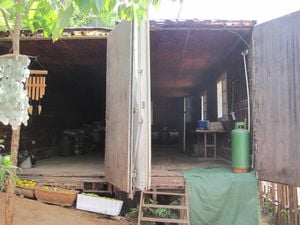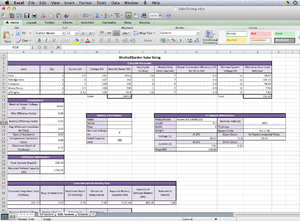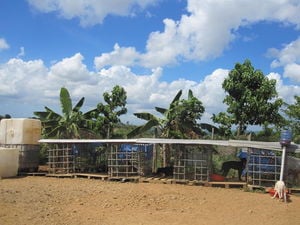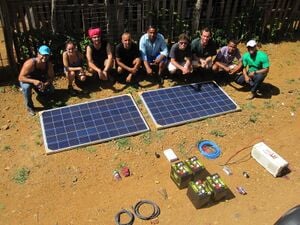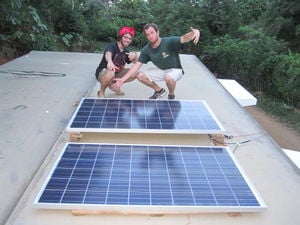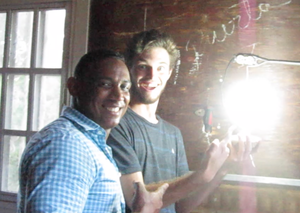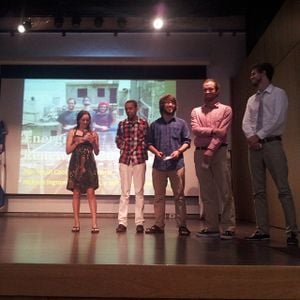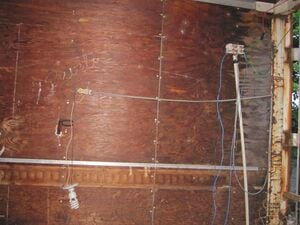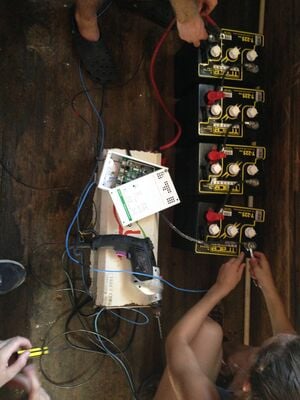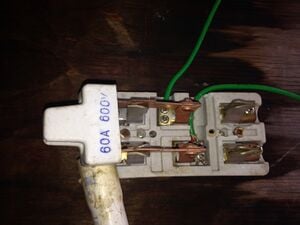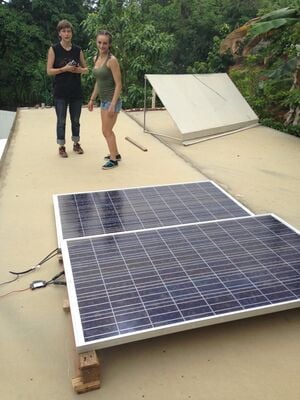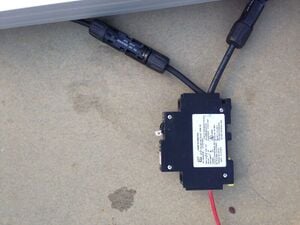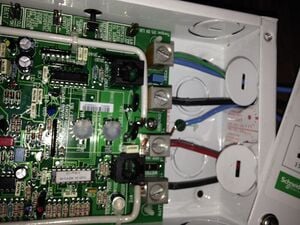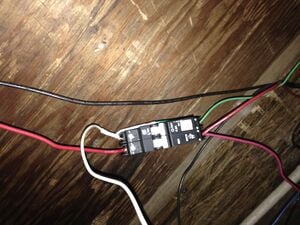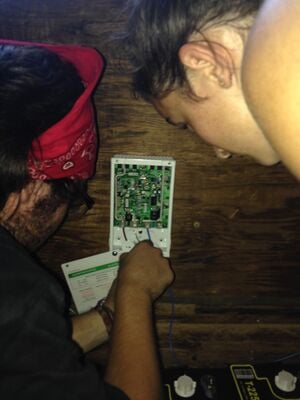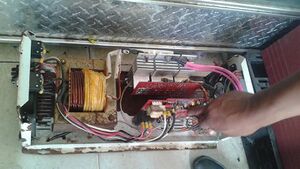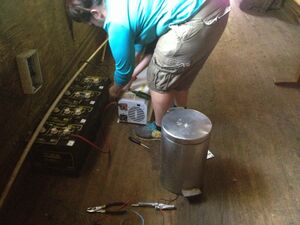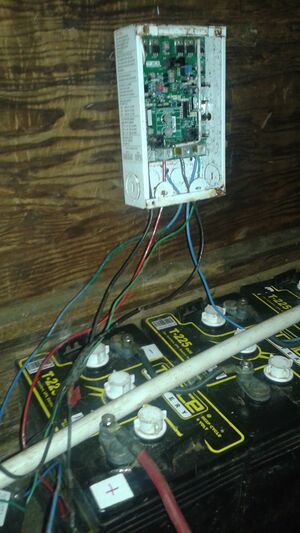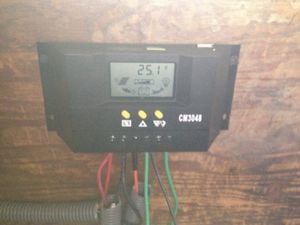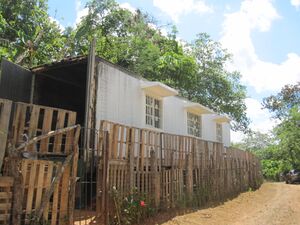
The following page will cover a variety of topics concerned with providing renewable energy to the Ghetto2Garden site in Dominican Republic. The background goes over the current conditions of the Ghetto2Garden site, as well as introduces the Renewable Energy team members. In the Problem Statement section a table is provided with the criteria and constraints of the project with a weight attached to each. The Literature Review covers a variety of topics related to renewable energy. Next, a timeline with descriptions of the project steps and completion dates is provided followed by a table with our project costs. Lastly, the page goes on to describe the step by step process by which a PV system is sized and installed.
Background[edit | edit source]
During the months of May through July in 2014, students from Cal Poly Humboldt in the Practivistas Dominicana Program are working in collaboration with Universidad Iberoamericana (UNIBE), Collectivo RevArk, and Ghetto2Garden. A group of five students consisting of Noah Coor, Jackson Ingram, Emily Klee, and Jeff Mosbacher are designing a project to provide solar energy that will power the electricity needs for Ghetto2Garden. Ghetto2Garden needs power for lighting, outlets, and a waterpump.
Problem statement[edit | edit source]
The objective of this project is to design and implement an alternative energy system that can produce power for Ghetto2Garden.
Criteria[edit | edit source]
The following table designates the criteria for completing our project weighted on a scale of 1-10, with 1 being of little importance and 10 being of the highest importance.
| Criteria | Weight | Constraint |
|---|---|---|
| Durability | 9 | The system must be able to withstand the various weather conditions of the Dominican Republic |
| Functionality | 10 | Must be able to power the clients needs and store excess electricity |
| Cost | 8 | Must not exceed the project budget |
| Material Locality | 6.5 | Materials must be locally available |
| Security & Safety | 9 | Must be a well protected and hidden system from theft as well as any possible physical harm to people and animals near by |
| Ease of Maintenance | 8.5 | System must require little maintenance and be easy to understand and work with |
| Aesthetics | 5 | System constructed in a visually pleasing way |
Literature Review[edit | edit source]
Here is a link to a review of the literature pertinent to the 2014 alternative energy project.
Construction[edit | edit source]
Listed below is a timeline of the events of the Renewable energy team and the objectives that were completed. This section includes a cost analysis of the project and its required materials, as well as a "How-To" table for the steps needed to size and assemble a Photovoltaic System.
Timeline[edit | edit source]
The following table outlines the tasks and dates for the project.
Costs[edit | edit source]
This is a cost budget for this project, which includes the quantity, and the Dominican peso and US dollar price for each item.
| Material | Quantity | Unit Price (RD$) | Total (RD$) | Total (US$) |
|---|---|---|---|---|
| 255 Watt Yingli Panda Solar Panel | 2 | 12,200.00 | 24,400.00 | 561.18 |
| Charge Controller | 1 | 5,400.00 | 5,400.00 | 124.20 |
| 6V Battery | 4 | 5,200.00 | 20,800.00 | 478.38 |
| Inverter 1.5 kW / 24 V | 1 | DONATED | 0.00 | 0.00 |
| Ground Fault Protection 63Amp | 1 | 3,300.00 | 3,300.00 | 75.90 |
| Lightning Protection 63Amp | 1 | 3,550.00 | 3,550.00 | 81.65 |
| 63Amp Breaker | 1 | 625.00 | 625.00 | 14.37 |
| 30Amp Breaker | 1 | 625.00 | 625.00 | 14.37 |
| Ground Wire | 1 | 100.00 | 100.00 | 2.30 |
| Terminal Connectors | 4 | 80.00 | 320.00 | 7.36 |
| Electrical Cable | 150 ft | 8.00 | 1,200.00 | 27.61 |
| Electrical Tape | 1 | 176.00 | 176.00 | 4.05 |
| Total Cost | $61,121.00 | $1,405.75 | ||
How to recreate[edit | edit source]
Step-by-step instructions on how this system was created.
Materials Needed[edit | edit source]
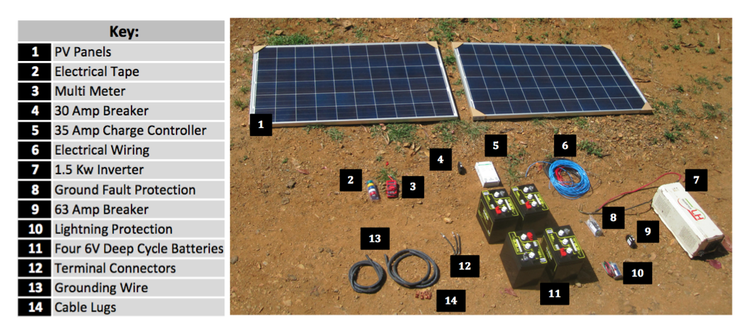
Part 1: Sizing the System[edit | edit source]
Use this spreadsheet to help determine how many modules and batteries you will need to use by plugging in the information from step 1. Do not solely rely on this excel spreadsheet for your final product, this is merely an approximation, be sure to get a second or third opinion from other sources on correct sizing.
Part 2: Assembling the System[edit | edit source]
NOTE: Depending on which model charger controller you are using, the order of the wiring will vary. It is important that you follow the installation instructions stated in your charge controller manual.
Design[edit | edit source]
A diagram of the systems wiring connections can be referenced below.
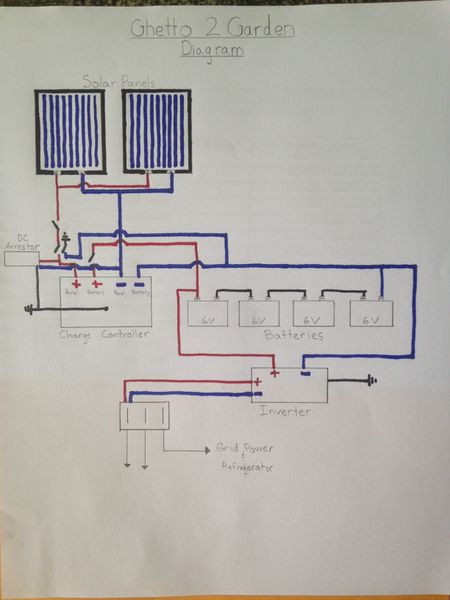
Operation[edit | edit source]
The following is a guide to the maintenance of the solar power system as well as information about its operation.
Maintenance[edit | edit source]
In order to keep this system up and running efficiently, periodic checks are mandatory. These check-ins involve inspecting the wires for all aspects of the system, and monitoring the solar charge controller. The panels must also be cleaned once a month, or after a storm in order to maintain panel efficiency. The batteries must also be replaced after their lifespan has ended.
Instructions[edit | edit source]
- When solar power is not needed, make sure switch is flipped to the right.
- When solar power is needed, flip switch to the left.
- During times of no sun, minimize energy consumption, and only use solar system when absolutely needed. Otherwise have switch flipped to the right.
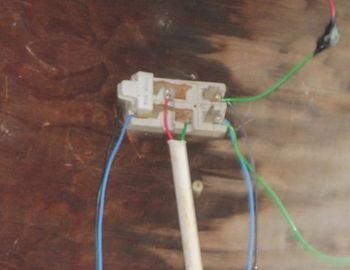
Conclusion[edit | edit source]
The following section addresses the teams results for the system at Ghetto2Garden, and discusses the things that could be added to improve the system as well as instructions for future users to troubleshoot the system.
Testing results[edit | edit source]
Upon completion of the installation of the solar PV system at Ghetto2Garden, the team was successfully able to verify the working condition of the system. After turning on both the breakers, the final test was to turn on the loads, which successfully worked.
Lessons learned[edit | edit source]
Some of the lessons that we learned while installing the PV system at Ghetto2Garden are discussed below.
- The battery monitor should be installed across the entire of the battery bank in order to monitor the batteries, instead of just one, even though the batteries are wired in series.
- Plan ahead and contact the people helping you install the system at least a day in advance to assure that you have the correct tools for the job.
- Always over-estimate the load that your system will need to produce. A little bit more electricity produced than is necessary is better than not having enough electricity.
- Follow the instructions that come with the solar charge controller, because the order of which you connect the wires to the controller matter.
- Our team learned a lot about the difference between alternating current (AC) and direct current (DC) current and how to wire the two different types. Specifically, make sure you have a bigger gauge of wire for the DC aspect of your system as opposed to the AC aspect of your system. The reasoning for this is that DC drops in voltage over a long distance, where AC can have smaller wires and can travel over much larger distances.
- Create a way for the panels that are laying flat on the ground to be raised up in order to create airflow underneath the panels when they get hot.
Next steps[edit | edit source]
The following are additional steps that groups in the future can do to improve upon the system at Ghetto2Garden.
- Install a mounting system for the panels, that will also secure them from any possible theft. For help with this step, contact Tito from La Yuca, who has some ideas in mind.
- Disconnect the battery monitor and connect it to the entire battery bank, instead of just one battery.
- Add a label for the battery monitor that says to flip the switch to the grid (to the right) once it reads a certain voltage, to allow the batteries to recharge.
Troubleshooting[edit | edit source]
Below is a chart that details some problems and solutions for the charge controller and other PV system components.
| Problem | Possible Cause | Solution |
|---|---|---|
| Charge Controller is overcharging battery (verified by measured current through the controller). | PV positive and Battery positive wires have been swapped. | Verify the voltage on PV terminal and Battery terminal are from the correct sources. |
| Charge Controller is locking up. | PV positive and Battery positive wires have been swapped. | Verify the voltage on PV terminal and battery terminal are from the correct sources. |
| Charge controller status LED blinks orange after switching on array breaker. | PV wires are connected in reverse polarity. | Verify PV polarity relative to battery negative. |
| Charge controller LED blinks orange at times during the solar day. | A) Controller is overheating. B) Array is supplying more current than the controller is rated for (press reset button and measure current). |
A) Check ambient air temperature around controller. B) Divide array with another controller or use large controller. |
| System is not providing power for as long as usual. | Batteries are becoming worn down. | Replace batteries. |
| System is providing little power. | Batteries may be drained. | Turn off solar power and allow for recharge of batteries. |
| System does not work. | A) Possible wire faulting. B) One or more of the appliances are faulty. |
A) Thoroughly investigate wires for visible damage and replace if needed. B) Replace one or more components of system if needed. |
Video[edit | edit source]
Team[edit | edit source]
The Renewable Energy Team of 2014 consists of the following Cal Poly Humboldt Engineering students, as well as Javier Duran Jr. from La Yuca. Also, a very special thanks to Tito from the La Yuca Community for providing his expert electrical knowledge and help.
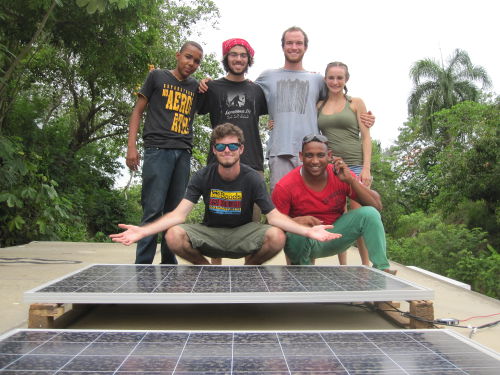
2015 Update[edit | edit source]
3D Model of System Wiring[edit | edit source]
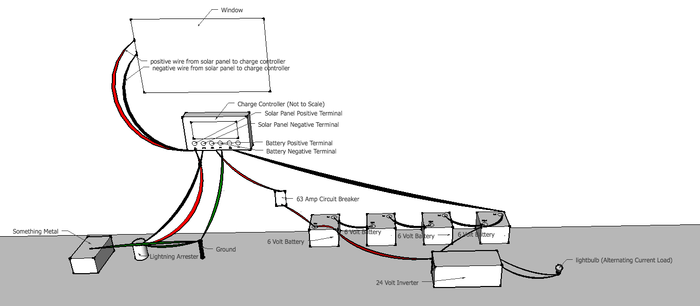

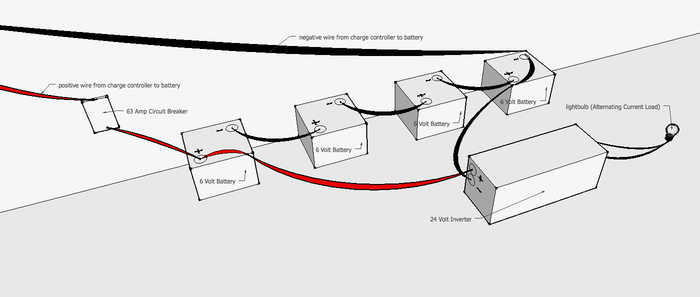
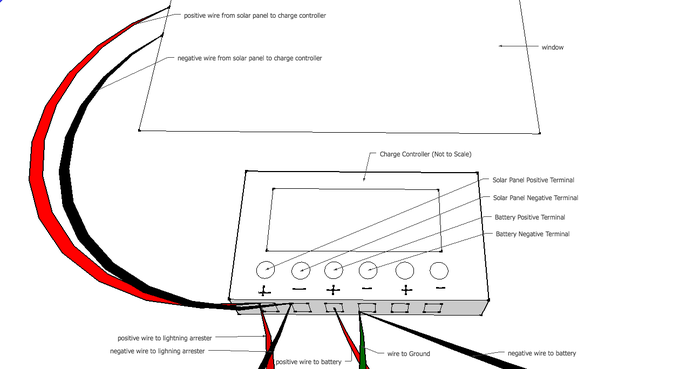
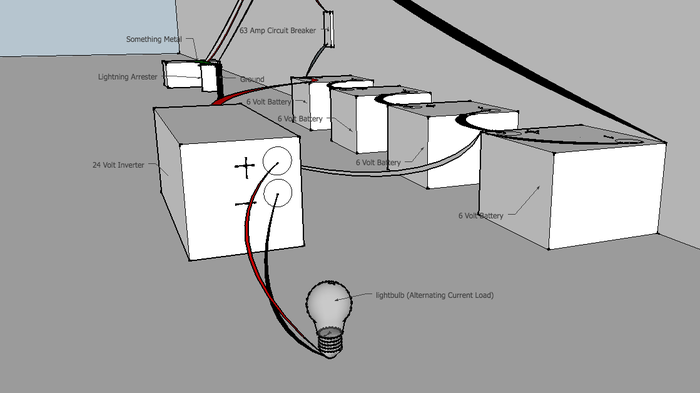
A New Year a New Solar Practivistas Team[edit | edit source]
A year had passed and the 2015 solar practivistas team traveled to the remote location of Ghetto2garden to see how the 2014 installation has held up. Throughout the six week project, we traveled to Ghetto2garden three times. The first time was to touch bases with Tomas about he system throughout the past year, analyze the functionality of the system, and retrieve any components that were in need of repair. We had only planned on going to Ghetto2garden twice but on the second trip more issues arose. The third and last trip to G2G time was spent tying up loose ends and a fully functioning solar energy system was established once again.
To learn more about what the 2015 solar team accomplished, go to Practivistas solar 2015
What Went Wrong[edit | edit source]
In our first visit, the team was informed that rats had gotten to the inverter so Tomas and his crew had taken apart some of the system components to try and fix it. In the process of rewiring these components, it was rewired incorrectly and the inverter still needed to be fixed. In the second trip, the team discovered that the charge controller was also broken but the cause was unknown. The batteries were wired incorrectly, two negative terminals were connected and two positive terminals were connected. After the two visits, what G2G needed to do was fix the inverter, fix the charge controller, and rewire the system.
Ghetto2Garden Generating Power[edit | edit source]
The team had fixed the inverter and was ready to return and follow up on the maintanence checks. When returning, it was realized the state of system was worse due to rats chewing through wires and the charge controller was not functioning. Luckily the panels and the rest of the system were working perfectly fine. The batteries were wired incorrectly but then once reconnecting them positive to negative and they started working. The lightning arrester needed to be rewired and fixed up, along with the charge controller.
Unfortunately, the charge controller was beyond repair and it needed to be replaced. The previous charge controller was 35 amps/24 volts and the new charge controller was 30 amps/48 Volts. We drove to ghetto2garden for the last time and reinstalled the components, rewired the lightning Arrestors and removed ground fault protection.
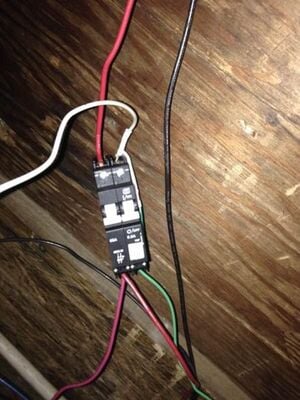
Charge controller installation and information manual Espanol
Our Brief Time in Ghetto2Garden[edit | edit source]
Throughout the three trips to G2G, the solar team learned with everyone the wiring of a system and how each component is wired together precisely with the assistance of Tito (an electrician from La Yuca). After many sweaty hours, many animals and many mangoes, the solar energy system was fully functioning again. Although our time with Tomas and his partners was very brief it was greatly enjoyed and I'm sure they look forward to future solar practivistas to return.

